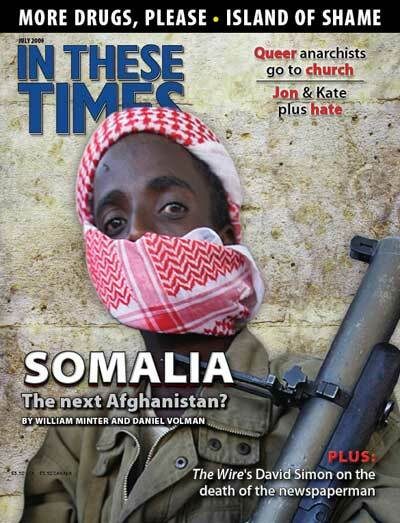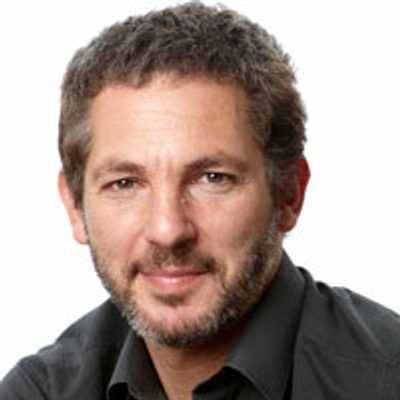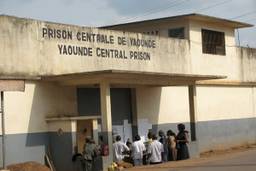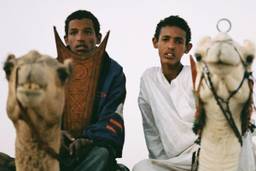Cinema in the Sand
Refugees and celebrities draw attention to a forgotten conflict.
Stefan Simanowitz

Nineteen-year-old Ibrahim Hussein Leibeit shifts his weight in obvious discomfort. The stump of his leg, blown off below the knee by a landmine just three weeks before, has yet to heal. “The pain is horrible,” he tells me, “but today it is possible for me to think about other things.” Leibeit is a refugee. He was born and raised in the isolated camps in southwest Algeria, where an estimated 165,000 Saharawi people have lived for more than three decades after fleeing their native Western Sahara.
Western Sahara, “Africa’s last colony,” was divided between Morocco and Mauritania by the Spanish when they withdrew in 1976 following the mass mobilization of Moroccans known as the Green March. The preceding year, the International Court of Justice had rejected Moroccan and Mauritanian claims to sovereignty over the territory, effectively recognizing the Saharawis’ right to independence. In February 1976, the Polisario Front, the Saharawi independence movement, declared creation of the Saharawi Arab Democratic Republic. A 15-year war over Western Sahara between the Moroccans and the Polisario Front ensued, with the Mauritanians withdrawing in 1979. In 1991, the fighting came to an end and, under the terms of a UN ceasefire agreement, a referendum for self-determination was promised. However, Morocco has continually blocked it, leaving the Saharawi refugees to live in four large camps in the inhospitable Algerian desert.
Home to nearly 30,000 of these refugees, Dakhla, named after a beautiful coastal city in Western Sahara, is the most remote of the camps. Located 175 kilometers from the nearest city, it has no paved roads and depends on outside supplies for food and water. In the summer, temperatures on the Hammada desert plain regularly top 120 degrees. With sandstorms and minimal vegetation, it is little wonder the area is known locally as the Devil’s Garden. Yet, incredibly, for one week each May, this desolate refugee camp plays host to the Sahara International Film Festival, a gala of screenings, workshops and concerts attended by an array of internationally acclaimed actors and filmmakers.
The festival was set up by award-winning Peruvian documentary filmmaker Javier Corcuera to both entertain and educate the refugees while also raising international awareness of the plight of the Saharawi people. More than 500 participants (mainly Spanish) flew into Tindouf on charter planes and traveled to the sprawling camp in a convoy of vehicles.
The festival was held in a spacious area in the center of the camp with a multiplex-sized outdoor screen. The central screen was surrounded by tents for workshops, exhibitions and indoor screenings. The program included more than 40 films from around the world. Themes mainly explored diverse experiences of struggle and hope, but there was some lighter entertainment and even an animated film for a crowd of refugee children. Audiovisual workshops run by the London-based charity Sandblast provided Saharawi refugees the opportunity to learn about filmmaking as well as create their own video messages. These were put online and can be seen by their extended families in Western Sahara.
The Sahara International Film Festival is gaining renown, helped by a number of famous Spanish actors, producers and directors, such as Penelope Cruz and Pedro Almodovar. This year, well-known attendees from the entertainment industry included actress Helena Anaya (Sex and Lucia), actor Eduardo Noriega (Vantage Point) and Oscar-nominated film director Javier Fesser. “We are mainly B- and C-listers” Noriega laughs. “Last year we had a proper A-lister in Javier Bardem.”
All visitors to the festival, including the celebrities, stay with Saharawi families, sharing their homes and their food. Living alongside the refugees gives visitors indelible insight into the conditions in which the refugees live. This experience motivates many participants to get involved in the campaign to lobby their respective governments to put political pressure on Morocco over the situation in Western Sahara. The campaign in Spain is growing steadily, but campaigners recognize that to effect real change the focus cannot just be on the Spanish government.
Privately, a Polisario representative admits concern about the rising level of militancy among some young Saharawis. After waiting with patient rage while countless UN resolutions were passed and ignored, many refugees are losing faith in the diplomatic process. Ibrahim Hussein Leibeit is one such young man. He took part in a march to the 1,553-mile, fortified barrier known as “the wall,” which was built by the Moroccans to stop the Saharawis from returning to their native land. In a symbolic gesture, Ibrahim was attempting to get close enough to the wall to throw a pebble to the other side when he trod on the landmine. He is rapidly becoming something of a hero to the Saharawi cause, a symbol of their defiance, and he has no regrets. “I would gladly lose my other leg if it would mean my country could be free,” he says in earnest.
At a dusty red carpet ceremony on the final day of the festival, the decision of the popular jury was announced and the White Camel award for best picture was picked up by producer Albert Noriega for the Steven Soderbergh film Che. The atmosphere was emotionally charged as participants and organizers, some waving flags of the Saharawi nation, took to the stage in a final act of solidarity with the refugees.
But as our convoy headed back across the expanse of empty desert, the mood started to change and thoughts turned to those we left behind. The further we drove, the more apparent it became just how isolated and abandoned the refugees are. During the war, captured Moroccan prisoners were not held behind walls or barbed-wire fences. Instead they were corralled into open compounds in the desert. Prisoners were free to leave at anytime; but in the Sahara, there is nowhere to go. Although conditions in the refugee camps are by no means wretched, Dakhla is essentially a desert prison.
Despite a tangible undercurrent of anger and frustration, the camp has not become a sea of despair. Y. Lamine Baali, Polisario’s UK representative, tells me that what fuels the Saharawis’ determination to carry on is a strong sense of injustice. A word heard a lot in Dakhla is “karama” – an Arabic word for strength and dignity. He explains, “Karama is the essence of our existence. The illegal occupation of our homeland is a terrible affront to our karama. When you hurt people in this way you threaten their whole existence.”
Return to action
I touch down in London, dusty and somewhat dazed, but with a rare clarity of purpose. The next day at work I take my boss aside and hand her my letter of resignation. While staying in the refugee camp in Dakhla, I realized that the lack of international awareness of the Saharawis’ struggle makes their desperate situation feel even more hopeless than it already is. And so I resolved to give up my day job and now work with the Free Western Sahara Campaign to move the story of the Saharawi refugees off the culture pages of magazines reporting on the festival and onto the international pages of all newspapers - where it belongs.
Next year, there will hopefully be flights to Tindouf from London, Paris and L.A. filled with actors, filmmakers and musicians, as well as others wanting to be part of the festival and show their solidarity with the Saharawi. In this way, the Sahara International Film Festival can become more of an international event, putting pressure on political decision-makers at the highest level and reminding the world of an otherwise forgotten conflict.
GET INVOLVED:
To help the Saharawi people or get involved in the next film festival go to:www.freesahara.ning.com
e:mail: freesaharacampaign@gmail.com








